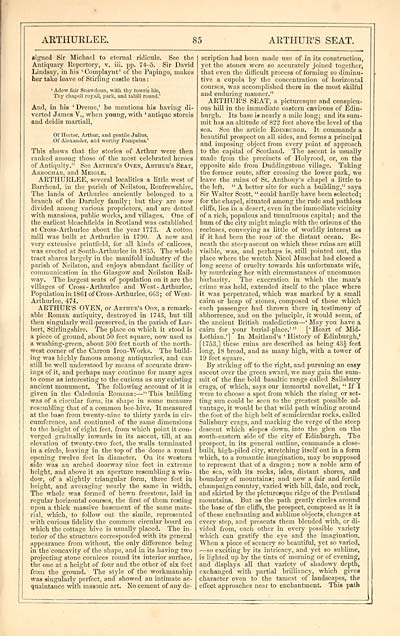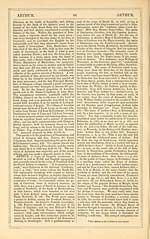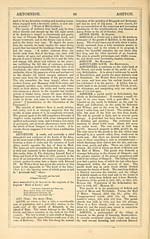Download files
Complete book:
Individual page:
Thumbnail gallery: Grid view | List view

ARTHURLEE.
85
ARTHUR'S SEAT.
signed Sir Michael to eternal ridicule. See the
Antiquary Repertory, v. iii. pp. 74--5. Sir David
Lindsay, in his ' Complayiit' Of the Papingo, makes
her take leave of Stirling castle thus:
*Adew fair Siiawdoun, with thy towris hio,
Thy chnpell royall, park, and tabill round.'
And, in his ' Dremo,' he mentions his having di-
verted James V., when young, with ' antique storeis
and deidis martiall,
Of Hector, Arthur, and gentile Julius,
Of Alexander, and worthy Pompeius.'
This shows that the stories of Arthur were then
ranked among those of the most celebrated heroes
of Antiquity." See Arthur's Oven, Arthur's Seat,
Arrochar, and Meigle.
ARTHURLEE, several localities a little west of
Barrhead, in the parish of Neilston, Renfrewshire.
The lands of Arthurlee anciently belonged to a
branch of the Damley family; but they are now
divided among various proprietors, and are dotted
with mansions, public works, and villages. One of
the earliest bleachfields in Scotland was established
at Cross-Arthurlee about the year 1773. A cotton
mill was built at Arthurlee in 1790. A new and
very extensive printfield, for all kinds of calicoes,
was erected at South-Arthurlee in 1835. The whole
tract shares largely in the manifold industry of the
parish of Neilston, and enjoys abundant facility of
communication in the Glasgow and Neilston Rail-
way. The largest seats of population on it are the
villages of Cross-Arthurlee and West- Arthurlee.
Population in 1861 of Cross- Arthurlee, 663; of West-
Arthurlee, 474.
ARTHUR'S OVEN, or Arthur's Oon, a remark-
able Roman antiquity, destroyed in 1743, but till
then singularly well -preserved, iu the parish of Lar-
bert, Stirlingshire. The place on which it stood is
a piece of ground, about 50 feet square, now used as
a washing-green, about 300 feet north of the north-
west comer of the Carron Iron- Works. The build-
ing was highly famous among antiquaries, and can
still be well understood by means of accurate draw-
ings of it, and perhaps may continue for many ages
to come as interesting to the curious as any existing
ancient monument. The following account of it is
given in the Caledonia Romana: — "This building
was of a circular form, its shape in some measure
resembling that of a common bee-hive. It measured
at the base from twenty-nine to thirty yards in cir-
cumference, and continued of the same dimensions
to the height of eight feet, from which point it con-
verged gradually inwards in its ascent, till, at an
elevation of twenty-two feet, the walls terminated
in a circle, leaving in the top of the dome a round
opening twelve feet in diameter. On its western
side was an arched doorway nine feet in extreme
height, and above it an aperture resembling a win-
dow, of a slightly triangular form, three feet in
height, and averaging nearly the same in width.
The whole was formed of hewn freestone, laid in
regular horizontal courses, the first of them resting
upon a thick massive basement of the same mate-
rial, which, to follow out the simile, represented
with curious fidelity the common circular board on
which the cottage hive is usually placed. The in-
terior of the structure corresponded with its general
appearance from without, the only difference being
in the concavity of the shape, and in its having two
projecting stone cornices round its interior surface,
the one at a height of four and the other of six feet
from the ground. The style of the workmanship
was singularly perfect, and showed an intimate ac-
quaintance with masonic art. No cement of any de-
scription had been made uso of in its construction,
yet the stones were so accurately joined together,
that even the difficult process of forming so diminu-
tive a cupola by the concentration of horizontal
courses, was accomplished there in the most skilful
and enduring manner."
ARTHUR'S SEAT, a picturesque and conspicu-
ous hill iu the immediate eastern environs of Edin-
burgh. Its base is nearly a mile long; and its sum-
mit has an altitude of 822 feet above the level of the
6ea. See the article Edinburgh. It commands a
beautiful prospect on all sides, and forms a principal
and imposing object from every point of approach
to the capital of Scotland. The ascent is usually
made from the precincts of Holyrood, or, on the
opposite side from Duddingstone village. Taking
the former route, after crossing the lower park, we
leave the ruins of St. Anthony's chapel a little to
the left. " A better site for such a building," says
Sir Walter Scott, " could hardly have been selected;
for the chapel, situated among the rude and pathless
cliffs, lies in a desert, even in the immediate vicinity
of a rich, populous and tumultuous capital ; and the
hum of the city might mingle with the orisons of the
recluses, conveying as little of worldly interest as
if it had been the roar of the distant ocean. Be-
neath the steep ascent on which these ruins are still
visible, was, and perhaps is, still pointed out, the
place where the wretch Nicol Muschat had closed a
long scene of cruelty towards his unfortunate wife,
by murdering her with circumstances of uncommon
barbarity. The execration in which the man's
crime was held, extended itself to the place where
it was perpetrated, which was marked by a small
cairn or heap of stones, composed of those which
each passenger had thrown there in, testimony of
abhorrence, and on the principle, it would seem, of
the ancient British malediction — ' May you have a
cairn for your burial-place.' " [' Heart of Mid-
Lothian.'] In Maitland's ' History of Edinburgh,'
[1753,] these ruins are described as being 43J feet
long, 18 broad, and as many high, with a tower of
19 feet square.
By striking off to the right, and pursuing an easy
ascent over the green sward, we may gain the sum-
mit of the fine bold basaltic range called Salisbury
crags, of which, says our immortal novelist, " If I
were to choose a spot from which the rising or set-
ting sun could be seen to the greatest possible ad-
vantage, it would be that wild path winding around
the foot of the high belt of semicircular rocks, called
Salisbury crags, and marking the verge of the steep
descent which slopes down, into the glen on the
south-eastern side of the city of Edinburgh. The
prospect, in its general outline, commands a close-
built, high-piled city, stretching itself out in a form
which, to a romantic imagination, may be supposed
to represent that of a dragon ; now a noble arm of
the sea, with its rocks, isles, distant shores, and
boundary of mountains ; and now a fair and fertile
champaign country, varied with hill, dale, and rock,
and skirted by the picturesque ridge of the Pentland
mountains. But as the path gently circles around
the base of the cliffs, the prospect, composed as it is
of these enchanting and sublime objects, changes at
every step, and presents them blended with, or di-
vided from, each other in every possible variety
which can gratify the eye and the imagination.
When a piece of scenery so beautiful, yet so varied,
— so exciting by its intricacy, and yet so sublime,
is lighted up by the tints of morning or of evening,
and displays all that variety of shadowy depth,
exchanged with partial brilliancy, which gives
character even to the tamest of landscapes, the
effect approaches near to enchantment. This path
85
ARTHUR'S SEAT.
signed Sir Michael to eternal ridicule. See the
Antiquary Repertory, v. iii. pp. 74--5. Sir David
Lindsay, in his ' Complayiit' Of the Papingo, makes
her take leave of Stirling castle thus:
*Adew fair Siiawdoun, with thy towris hio,
Thy chnpell royall, park, and tabill round.'
And, in his ' Dremo,' he mentions his having di-
verted James V., when young, with ' antique storeis
and deidis martiall,
Of Hector, Arthur, and gentile Julius,
Of Alexander, and worthy Pompeius.'
This shows that the stories of Arthur were then
ranked among those of the most celebrated heroes
of Antiquity." See Arthur's Oven, Arthur's Seat,
Arrochar, and Meigle.
ARTHURLEE, several localities a little west of
Barrhead, in the parish of Neilston, Renfrewshire.
The lands of Arthurlee anciently belonged to a
branch of the Damley family; but they are now
divided among various proprietors, and are dotted
with mansions, public works, and villages. One of
the earliest bleachfields in Scotland was established
at Cross-Arthurlee about the year 1773. A cotton
mill was built at Arthurlee in 1790. A new and
very extensive printfield, for all kinds of calicoes,
was erected at South-Arthurlee in 1835. The whole
tract shares largely in the manifold industry of the
parish of Neilston, and enjoys abundant facility of
communication in the Glasgow and Neilston Rail-
way. The largest seats of population on it are the
villages of Cross-Arthurlee and West- Arthurlee.
Population in 1861 of Cross- Arthurlee, 663; of West-
Arthurlee, 474.
ARTHUR'S OVEN, or Arthur's Oon, a remark-
able Roman antiquity, destroyed in 1743, but till
then singularly well -preserved, iu the parish of Lar-
bert, Stirlingshire. The place on which it stood is
a piece of ground, about 50 feet square, now used as
a washing-green, about 300 feet north of the north-
west comer of the Carron Iron- Works. The build-
ing was highly famous among antiquaries, and can
still be well understood by means of accurate draw-
ings of it, and perhaps may continue for many ages
to come as interesting to the curious as any existing
ancient monument. The following account of it is
given in the Caledonia Romana: — "This building
was of a circular form, its shape in some measure
resembling that of a common bee-hive. It measured
at the base from twenty-nine to thirty yards in cir-
cumference, and continued of the same dimensions
to the height of eight feet, from which point it con-
verged gradually inwards in its ascent, till, at an
elevation of twenty-two feet, the walls terminated
in a circle, leaving in the top of the dome a round
opening twelve feet in diameter. On its western
side was an arched doorway nine feet in extreme
height, and above it an aperture resembling a win-
dow, of a slightly triangular form, three feet in
height, and averaging nearly the same in width.
The whole was formed of hewn freestone, laid in
regular horizontal courses, the first of them resting
upon a thick massive basement of the same mate-
rial, which, to follow out the simile, represented
with curious fidelity the common circular board on
which the cottage hive is usually placed. The in-
terior of the structure corresponded with its general
appearance from without, the only difference being
in the concavity of the shape, and in its having two
projecting stone cornices round its interior surface,
the one at a height of four and the other of six feet
from the ground. The style of the workmanship
was singularly perfect, and showed an intimate ac-
quaintance with masonic art. No cement of any de-
scription had been made uso of in its construction,
yet the stones were so accurately joined together,
that even the difficult process of forming so diminu-
tive a cupola by the concentration of horizontal
courses, was accomplished there in the most skilful
and enduring manner."
ARTHUR'S SEAT, a picturesque and conspicu-
ous hill iu the immediate eastern environs of Edin-
burgh. Its base is nearly a mile long; and its sum-
mit has an altitude of 822 feet above the level of the
6ea. See the article Edinburgh. It commands a
beautiful prospect on all sides, and forms a principal
and imposing object from every point of approach
to the capital of Scotland. The ascent is usually
made from the precincts of Holyrood, or, on the
opposite side from Duddingstone village. Taking
the former route, after crossing the lower park, we
leave the ruins of St. Anthony's chapel a little to
the left. " A better site for such a building," says
Sir Walter Scott, " could hardly have been selected;
for the chapel, situated among the rude and pathless
cliffs, lies in a desert, even in the immediate vicinity
of a rich, populous and tumultuous capital ; and the
hum of the city might mingle with the orisons of the
recluses, conveying as little of worldly interest as
if it had been the roar of the distant ocean. Be-
neath the steep ascent on which these ruins are still
visible, was, and perhaps is, still pointed out, the
place where the wretch Nicol Muschat had closed a
long scene of cruelty towards his unfortunate wife,
by murdering her with circumstances of uncommon
barbarity. The execration in which the man's
crime was held, extended itself to the place where
it was perpetrated, which was marked by a small
cairn or heap of stones, composed of those which
each passenger had thrown there in, testimony of
abhorrence, and on the principle, it would seem, of
the ancient British malediction — ' May you have a
cairn for your burial-place.' " [' Heart of Mid-
Lothian.'] In Maitland's ' History of Edinburgh,'
[1753,] these ruins are described as being 43J feet
long, 18 broad, and as many high, with a tower of
19 feet square.
By striking off to the right, and pursuing an easy
ascent over the green sward, we may gain the sum-
mit of the fine bold basaltic range called Salisbury
crags, of which, says our immortal novelist, " If I
were to choose a spot from which the rising or set-
ting sun could be seen to the greatest possible ad-
vantage, it would be that wild path winding around
the foot of the high belt of semicircular rocks, called
Salisbury crags, and marking the verge of the steep
descent which slopes down, into the glen on the
south-eastern side of the city of Edinburgh. The
prospect, in its general outline, commands a close-
built, high-piled city, stretching itself out in a form
which, to a romantic imagination, may be supposed
to represent that of a dragon ; now a noble arm of
the sea, with its rocks, isles, distant shores, and
boundary of mountains ; and now a fair and fertile
champaign country, varied with hill, dale, and rock,
and skirted by the picturesque ridge of the Pentland
mountains. But as the path gently circles around
the base of the cliffs, the prospect, composed as it is
of these enchanting and sublime objects, changes at
every step, and presents them blended with, or di-
vided from, each other in every possible variety
which can gratify the eye and the imagination.
When a piece of scenery so beautiful, yet so varied,
— so exciting by its intricacy, and yet so sublime,
is lighted up by the tints of morning or of evening,
and displays all that variety of shadowy depth,
exchanged with partial brilliancy, which gives
character even to the tamest of landscapes, the
effect approaches near to enchantment. This path
Set display mode to: Large image | Transcription
Images and transcriptions on this page, including medium image downloads, may be used under the Creative Commons Attribution 4.0 International Licence unless otherwise stated. ![]()
| Gazetteers of Scotland, 1803-1901 > Imperial gazeteer of Scotland, or, Dictionary of Scottish topography > Volume 1 > (177) Page 85 |
|---|
| Permanent URL | https://digital.nls.uk/97461254 |
|---|
| Description | Volume I: Aan-Gordon. |
|---|---|
| Attribution and copyright: |
|

